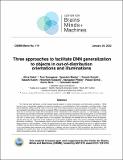| dc.contributor.author | Sakai, Akira | |
| dc.contributor.author | Sunagawa, Taro | |
| dc.contributor.author | Madan, Spandan | |
| dc.contributor.author | Suzuki, Kanata | |
| dc.contributor.author | Katoh, Takashi | |
| dc.contributor.author | Kobashi, Hiromichi | |
| dc.contributor.author | Pfister, Hanspeter | |
| dc.contributor.author | Sinha, Pawan | |
| dc.contributor.author | Boix, Xavier | |
| dc.contributor.author | Sasaki, Tomotake | |
| dc.date.accessioned | 2022-01-26T16:08:10Z | |
| dc.date.available | 2022-01-26T16:08:10Z | |
| dc.date.issued | 2022-01-26 | |
| dc.identifier.uri | https://hdl.handle.net/1721.1/139741 | |
| dc.description.abstract | The training data distribution is often biased towards objects in certain orientations and illumination conditions. While humans have a remarkable capability of recognizing objects in out-of-distribution (OoD) orientations and illu- minations, Deep Neural Networks (DNNs) severely suffer in this case, even when large amounts of training examples are available. In this paper, we investigate three different approaches to improve DNNs in recognizing objects in OoD orientations and illuminations. Namely, these are (i) training much longer after convergence of the in-distribution (InD) validation accuracy, i.e., late-stopping, (ii) tuning the momentum parameter of the batch normalization layers, and (iii) enforcing invariance of the neural activity in an intermediate layer to orientation and illumination conditions. Each of these approaches substantially improves the DNN’s OoD accuracy (more than 20% in some cases). We report results in four datasets: two datasets are modified from the MNIST and iLab datasets, and the other two are novel (one of 3D rendered cars and another of objects taken from various controlled orientations and illumination conditions). These datasets allow to study the effects of different amounts of bias and are challenging as DNNs perform poorly in OoD conditions. Finally, we demonstrate that even though the three approaches focus on different aspects of DNNs, they all tend to lead to the same underlying neural mechanism to enable OoD accuracy gains – individual neurons in the intermediate layers become more selective to a category and also invariant to OoD orientations and illumina- tions. We anticipate this study to be a basis for further improvement of deep neural networks’ OoD generalization performance, which is highly demanded to achieve safe and fair AI applications. | en_US |
| dc.description.sponsorship | This material is based upon work supported by the Center for Brains, Minds and Machines (CBMM), funded by NSF STC award CCF-1231216. | en_US |
| dc.publisher | Center for Brains, Minds and Machines (CBMM) | en_US |
| dc.relation.ispartofseries | CBMM Memo;119 | |
| dc.subject | Out-of-distribution Generalization | en_US |
| dc.subject | Object Recognition in Novel Conditions | en_US |
| dc.subject | Neural Invariance | en_US |
| dc.subject | Neural Selectivity | en_US |
| dc.subject | Neural Activity Analysis | en_US |
| dc.title | Three approaches to facilitate DNN generalization to objects in out-of-distribution orientations and illuminations | en_US |
| dc.type | Article | en_US |
| dc.type | Technical Report | en_US |
| dc.type | Working Paper | en_US |
